Central New Jersey and Eastern Pennsylvania are home to a number of damaging diseases that infect trees and shrubs. Learning to identify them is the first step in preventing an outbreak that could seriously injure, or even kill, your trees.
In this article, we share five tree and shrub diseases commonly found in our area and describe what to look out for, the trees or shrubs that are typically infected, and available treatment or control options.
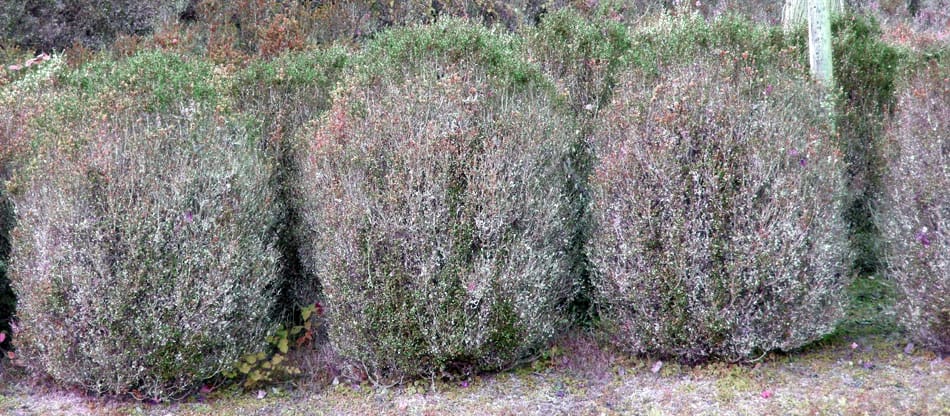
Row of boxwoods exhibiting browning and defoliation from boxwood blight. Photo by Mary Ann Hansen, Virginia Polytechnic Institute and State University, Bugwood.org.
Boxwood Blight
This is an aggressive disease caused by the fungus Cylindrocladium pseudonaviculatum. It spreads quickly and easily, particularly in warm and humid conditions.
Boxwood blight causes severe defoliation, as well as elongated dark-brown/black lesions (also called cankers) on plant stems that lead to stem dieback. Eventually, the entire shrub will die.
There is no cure for boxwood blight so prevention is the best option. Professionally-applied fungicides can be effective in protecting healthy plants.
Boxwoods that are infected should be completely removed (including all fallen leaves and debris), bagged and disposed of in the trash to prevent the disease from spreading to other boxwood shrubs.
Targets: Beside boxwood, pachysandra and sweetbox can both host the fungus, multiplying the source of fungal spores that can spread to cause new infections.
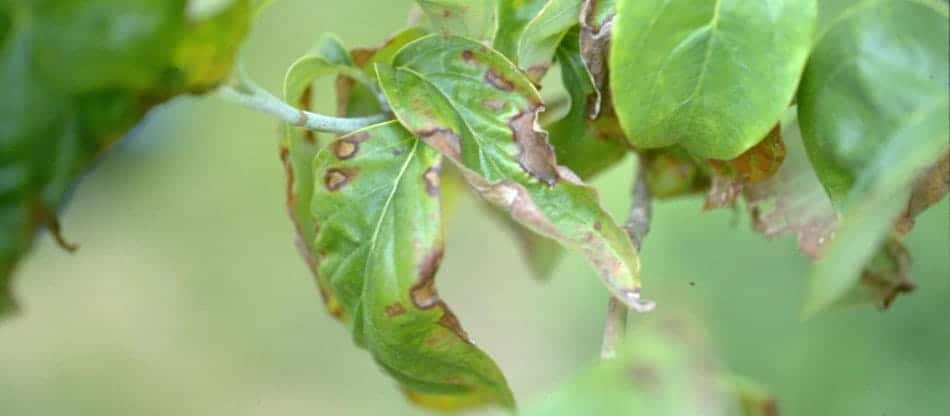
Anthracnose on dogwood leaves. Photo by John Hartman, University of Kentucky, Bugwood.org.
Anthracnose
This fungal disease is found throughout the eastern states and is particularly prevalent in our area.
The exact cause of anthracnose depends on the tree or plant being attacked; different fungi infect different plants. As a result, the symptoms also vary from tree to tree, although they usually include spots or lesions on leaves and/or twigs, curling leaves, dried up leaves, and defoliation. Healthy trees can generally survive one or two years of defoliation but, after that, they begin to decline.
Symptoms tend to be more severe after extended cool, wet spring weather – the fungus cannot spread in dry conditions.
The disease can be managed through timely application of specific fungicides before symptoms develop. When planting a new tree, look for cultivars that are resistant to anthracnose.
Infected and susceptible trees can be pruned in winter to increase sunlight and airflow throughout the canopy. All leaf litter and debris should be raked up and disposed of in fall to help prevent reinfection in spring.
Targets: Commonly found on ash, maple, oak, sycamore and dogwood
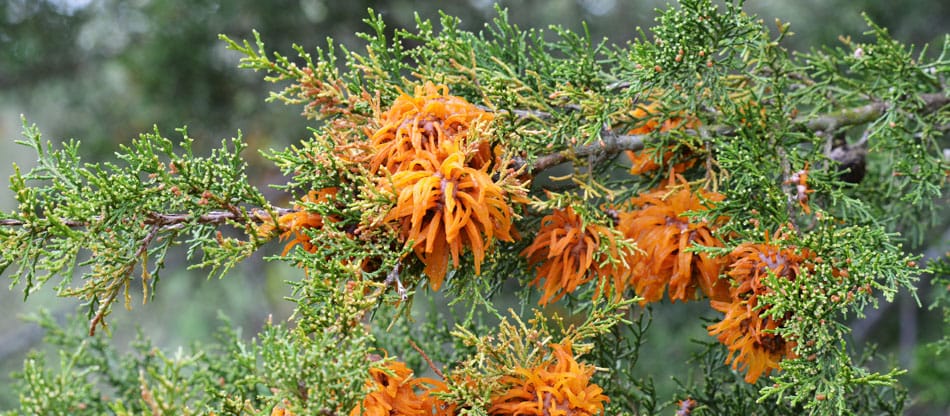
The hard-to-miss spore horns of the cedar-apple rust fungus on a juniper branch.
Hawthorn Rust & Cedar-Apple Rust
These two diseases are very similar and are caused by fungi in the genus Gymnosporangium.
What makes this disease interesting is that the fungus spends part of its life cycle on trees and shrubs of the Juniperus species, such as Eastern red cedar and common juniper. Although it doesn’t kill Juniperus spp., it does cause galls to form on small branches, followed by bright orange tentacle-like spore horns during wet conditions in late spring.
The leaves on deciduous trees infected with this disease develop yellow spots with a darker orangish center shortly after spring flower bloom. Later in the season, you’ll see similar spots and rotted areas on the fruit.
Consider planting trees that are immune or resistant to rust diseases and avoiding planting junipers nearby. Control can be achieved by spraying a fungicide at bud break (usually in mid- to late-April in our area) and then weekly until flower petals fall.
Targets: Apple, flowering crabapple, hawthorn
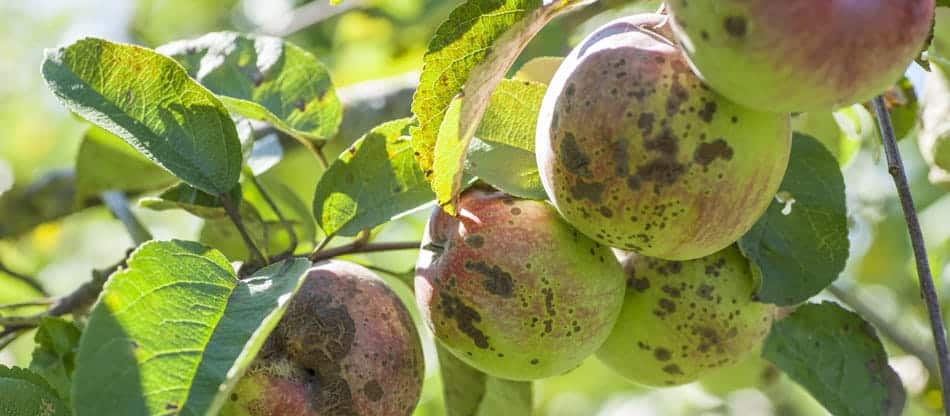
Apple scab lesions on apples and leaves
Apple Scab
Another fungal disease, apple scab results in leaf lesions that form in late spring. Leaves become chlorotic (yellowish) and fall off over the summer, sometimes leaving the tree completely defoliated. Fruit will also develop circular dark brown spots and become deformed; they often rot and drop prematurely.
Besides the aesthetic issues caused by apple scab, it also weakens the tree and makes it more vulnerable to other diseases and pests.
The best treatment for apple scab is a spring fungicide application to reduce the severity of the disease. Infected branches can be pruned out, all fallen fruit and leaves should be disposed of (not in the compost!), and winter pruning to open up the canopy can also be helpful.
Targets: Apple, crabapple
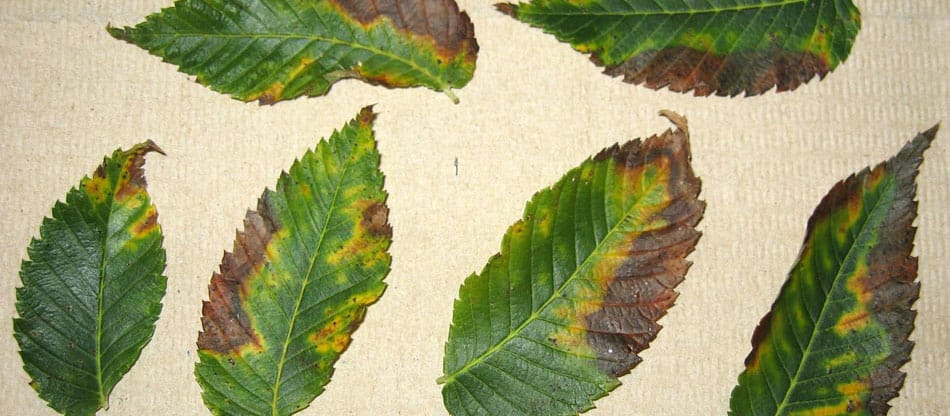
Bacterial leaf scorch symptoms on elm leaves. Photo by Sandra Jensen, Cornell University, Bugwood.org.
Bacterial Leaf Scorch
Unlike the other tree diseases described here, bacterial leaf scorch (BLS) is caused by a bacterium – specifically, Xylella fastidiosa. The bacteria are spread from tree to tree by spittlebugs, treehoppers, and leafhoppers that feed on the leaves.
BLS causes leaf edges to turn brown, dry up and die. Depending on the tree species, the entire leaf may die, leaves may drop prematurely and branches may die. The disease spreads from branch to branch and gets progressively worse each year that the tree is infected; eventually, BLS will kill the tree.
Symptoms often look very similar to those caused by drought, extreme heat or damage that prevents the tree from taking up moisture from the soil.
The only known effective treatment is to inject infected trees with the antibiotic tetracycline. This will temporarily alleviate symptoms but does not cure the tree of the disease; injections must be repeated yearly to continuously protect the tree.
Targets: Oak (primarily pin, red and white oak), elm, sycamore, mulberry, red maple, and sweetgum
What To Do if Your Tree is Infected
If you notice symptoms of any of these tree diseases or are concerned that your tree may be at risk, call us at 908-309-6611 right away to arrange for a complimentary inspection by a Certified Arborist. You can also contact us online to set up a tree inspection.
With all of these diseases, timely treatment is key to protecting your trees. Most treatments are applied in spring to prevent infection or control its spread.
The worst thing you can do is nothing. Unfortunately, none of these diseases will “go away” on their own. In fact, all will continue to worsen and spread to other trees or shrubs in your landscape. Eventually, the only remaining option will be tree removal, which is much more costly and invasive than proactive and preventive treatment.
GET THE LATEST NEWS
Subscribe to the Organic Plant Care Newsletter and get timely and helpful tips and updates monthly.
There's no spam - we promise!





